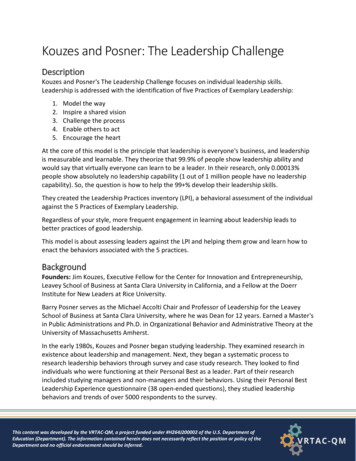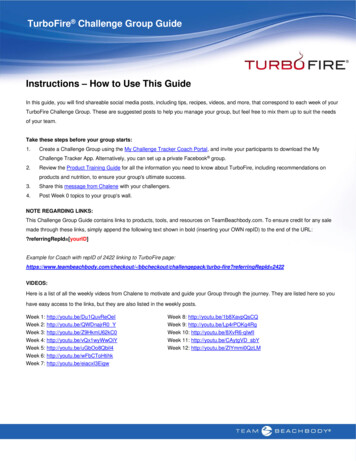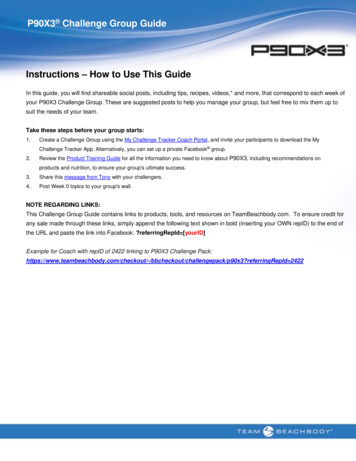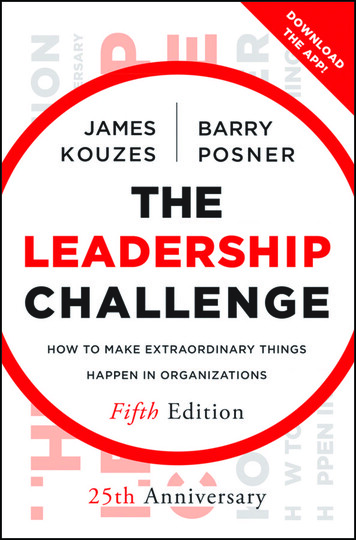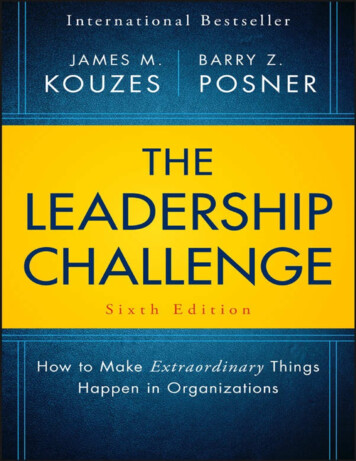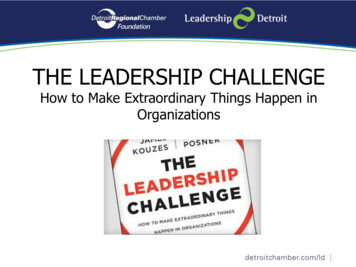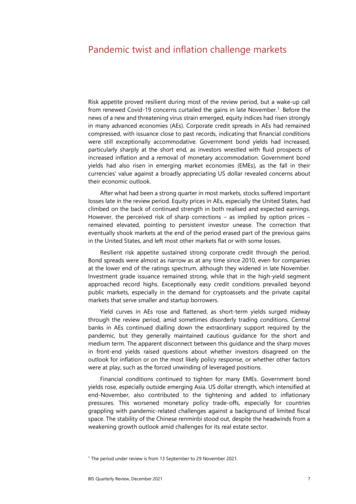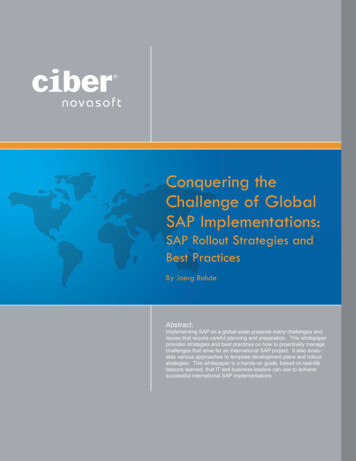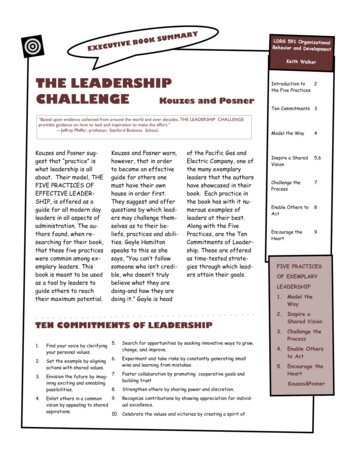
Transcription
MMAOK SUOBEVTIEXECURYLDRS 591 OrganizationalBehavior and DevelopmentKeith WalkerTHE LEADERSHIPKouzes and PosnerCHALLENGE“Based upon evidence collected from around the world and over decades, THE LEADERSHIP CHALLENGEprovides guidance on how to lead and inspiration to make the effort.”—Jeffrey Pfeffer, professor, Stanford Business School,Kouzes and Posner suggest that “practice” iswhat leadership is allabout. Their model, THEFIVE PRACTICES OFEFFECTIVE LEADERSHIP, is offered as aguide for all modern dayleaders in all aspects ofadministration. The authors found, when researching for their book,that these five practiceswere common among exemplary leaders. Thisbook is meant to be usedas a tool by leaders toguide others to reachtheir maximum potential.Kouzes and Posner warn,however, that in orderto become an effectiveguide for others onemust have their ownhouse in order first.They suggest and offerquestions by which leaders may challenge themselves as to their beliefs, practices and abilities. Gayle Hamiltonspeaks to this as shesays, ”You can’t followsomeone who isn’t credible, who doesn’t trulybelieve what they aredoing-and how they aredoing it.” Gayle is headof the Pacific Gas andElectric Company, one ofthe many exemplaryleaders that the authorshave showcased in theirbook. Each practice inthe book has with it numerous examples ofleaders at their best.Along with the FivePractices, are the TenCommitments of Leadership. These are offeredas time-tested strategies through which leaders attain their goals.TEN COMMITMENTS OF LEADERSHIP1.Find your voice by clarifyingyour personal values.2.Set the example by aligningactions with shared values.3.4.5.Search for opportunities by seeking innovative ways to grow,change, and improve.6.Experiment and take risks by constantly generating smallwins and learning from mistakes.7.Foster collaboration by promoting cooperative goals andbuilding trustEnvision the future by imagining exciting and ennobling8.possibilities.9.Enlist others in a commonvision by appealing to sharedaspirations.Strengthen others by sharing power and discretion.Recognize contributions by showing appreciation for individual excellence.10. Celebrate the values and victories by creating a spirit ofIntroduction to2the Five PracticesTen Commitments 3Model the Way4Inspire a SharedVision5,6Challenge theProcess7Enable Others toAct8Encourage theHeart9FIVE PRACTICESOF EXEMPLARYLEADERSHIP1. Model theWay2. Inspire aShared Vision3. Challenge theProcess4. Enable Othersto Act5. Encourage theHeartKouzes&Posner
AN INTODUCTION TO THE FIVE PRACTICESVery simply put-”YOU MUST LEADFROM WHAT YOU BELIEVE.” (AlanKeith) This statement sums up the wholemodel of the Five Practices. If you donot truly believe in what youare telling your staff, or you donot model behaviors that youwish your staff to portray, howcan you possibly hope to havepeople who believe and trustenough in you to follow yourleadership? The old adage,“actions speak louder thanwords”, is never truer than when dealingwith people. If you hope to be a successful leader in whatever profession,you must lead by example-Model theWay. In order to beable to model, one musthave a clear vision of whatis needed and of what theend result will be. Youmust be able to get thatvision from idea stage toone where others see it aswell-Inspire a SharedVision. Leaders must be able to takerisks and do everything that they wouldask others to do, whether it is moppinga spill on the floor to learning a newskill-Challenge the Process. Leadership is not a singular process but a relationship with others, good leaders usethe term, ‘’we’’, more often than “I.”Good leaders share power-Enable Others to Act. Finally, leadership involvesappreciation, encouragement and caring,thus– Encouraging the Heart.IF YOU DON’T BELIEVE THEMESSENGER, YOU WON’T BELIEVE THE MESSAGE.WHAT PEOPLE LOOK FOR AND ADMIRE IN THEIR LEADERSWhile researching for their book,the authors interviewed thousands of business executives. Thequestion put to them was, “Whatvalues do you look for and admirein your leader?” In response, 225different characteristics, traitsand values were given. Amongthese, in over 50% of the time,STAYINGfour characteristics stood out.These were: honesty, forwardlooking, competent, and inspiring.Through 3 editions of their book,from 1987 to 2002, these fourcharacteristics remained in thelead. Honesty was always at thetop of the scale. Along with honesty are the traits of being prin-cipled andethical. People want tohave leadersthat have integrity andare credible.“Leadership isultimately aboutcreating a way forpeople tocontribute to makesomethingextraordinaryhappenAlan Keith,LUCAS DIGITALIN LOVEU.S. Army Major General John H. Stanford was asked by the authors how hewould continue to develop leaders in themilitary or even private practice. Hisanswer was not the typical strategyladen one. Stanford said, ‘’When anyoneasks me that question, I tell them Ihave the secret to success in life. Thesecret to success is to stay in love.Staying in love gives you the power toignite other people, to see inside otherpeople, to have a greater desire to getthings done than other people.” Thisstatement is true no matter what fieldof endeavor you are in. A teacher whois in love with the profession of teachingwill empower the students to grow andlearn. The children see that love in theteacher and respond to that teacher asleader.LDRS 591 Organizational Behavior and DevelopmentLeadership is not anaffair of the head. Leadership isan affair of the heart.Page 2
TEN COMMITMENTS OF LEADERSHIP : A summary of the strategies tohelp reach your goals.1. FIND YOUR VOICE BYthis medium.CLARIFYING YOUR PERSONAL D. Questions are teaching opportunities.VALUES.They generate ideas and empower peopleA. Look in the mirror, becomingto believe in themselves.more self aware. One way is by using3. ENVISION THE FUTURE BYthe LEADERSHIP PRACTICES INIMAGINING THE EXCITING ANDVENTORY. Ask for feedback on yourENNOBLING POSSIBILITIESpractices.B. Take some quiet time to reflecton behaviors and beliefs.C. Watch others and learn fromthose you admire.D. Take time to identify and listvalues.E. Take realistic stock of your ability to succeed .2.SET THE EXAMPLE BY ALIGNING ACTIONS WITH SHAREDVALUES.A. Know what you are talking about.B. Reinforce values and beliefsthrough posters, pins, pictures andceremonies.C. Relate stories of success to others, people relate to others throughA. Research past visionary leadersAnd borrow something from themto make your own.B. Collectively create a vision.C. Be positive about your vision,believein it with all your heart, then otherswill to.D. Listen, listen, listen.5.SEARCH FOR OPPORTUNITIESBY SEEKING INNOVATIVE WAYSTO CHANGE, GROW AND IMPROVE.A.B. Think about your past and look forward to what you must do.B.C. Create a Vision statement, givevoice and wings to your dream.D. Visualize yourself on your way toachieving your goal.4. ENLIST OTHERS IN A COMMON VISION BY APPEALING TOSHARED ASPIRATIONSA. Get to know the people you areworking with and find some commonalities.Challenge yourself and others,making every task an adventure.Read: FUN WORKS:CREATINGPLACES WHERE PEOPLE LOVETO WORK by Leslie Yerkes.C. Change make-up of teams on aregular basis.HELP BEGETS HELPJUST AS TRUSTBEGETS TRUST7. FOSTER COLLABORATION BYPROMOTING COOPERATIVE6.EXPERIMENT AND TAKE RISKS BY CONSTANTLY GENERATGOALS AND BUILDING TRUST.ING SMALL WINS AND LEARNING FROM MISTAKES.A. Promote and conduct positiveA. Create a climate of change, do not be afraid of changing.face-to-face interactions, thisB. Change by taking small steps at first and celebrating small wins tobuilds trust.encourage further risk taking.B. When listening, ask questionsC. Foster an atmosphere of safety-it is okay to make mistakes. Whenfor clarification, seek to underleaders make mistakes, good leaders talk about what they havestand the other’s perspectives.learned from their mistake.C. In planning and discussions, useD. Take inventories often. Question how you are doing, what is work“we”, not “I.”ing well, what can be improved. Celebrate successes!D. Create opportunities for inforE. Choices empower people to believe that they matter in the grandmal interactions, encourage “humanscheme of things. Choice commitment and ownership.moments” throughout the day.LDRS 591 Organizational Behavior and DevelopmentPage 3
TEN COMMITMENTS, continued8. STRENGTHEN OTHERS BYSHARING POWER AND DISCRETION.A. Assure that individual andgroup accomplishments andefforts get noticed.9. RECOGNIZE CONTRIBUTIONS BY SHOWING APPRECIATIONFOR INDIVIDUAL EXCELLENCE.A Recognize excellence, say Thank You, and promote positive expectations.B. Encourage goal setting, in yourself and others.10.CELEBRATE THE VALUES AND VICTORIES BY CREATING AB. Make sure people’s jobs areSPIRIT OF COMMUNITY.enriching and that they feel aA. Create opportunities to celebrate accomplishments in public.sense of accomplishment.B. Build team spirit by holding celebrations, rituals, and holding on to cusC. Assign higher profile tasks totoms. Celebrate birthdays and transitions.others to ensure they get noticed and grow.1. MODEL THE WAYBy modeling desired behavior, leaders getmore commitment and higher work standards from their employees. Leaders mustbuild credibility through what they say aswell as by what they do. An exemplaryleader is able to articulate his beliefs sothat others may understand and seewhere he is coming from. As well, theleader must assure that his actions fit hiswords. A leader’s values must fit in withhis behaviors and expectations of other’sbehaviors. Values are what keep us going,they are the guidelines by which we liveour lives, at work and at play. As Kouzesand Posner write, “Values constitute ourKouzes and Posner suggest that leadership is a performing art. A leader learnsto “ act “ in the manner required to getpeople to come on board. Leaders enactdecisions in order to get to their goals.The authors go further to suggest that“ setting an example is essentially doingwhat you say you will do.” Clarificationof values is extremely important as isthe consistency by which leaders showthat they are worthy leaders to follow.bottom line.” Further to this they add,“.inform our decisions as to what to doand what not to do.” Leaders need to beclear on their values and be able toshare these values through their ownvoice. In doing this ,leaders becomeauthentic, leading from the inside. People gauge your value as a leader by whatyou do, more than by what you say.“ YOU HAVE TO BELIEVE IN SOMETHING YOURSELF FIRST, BEFOREYOU CAN GET OTHERS TO BELIEVE.” Ashraf Seddeek, Oracle Corp.YOU CAN’TBELIEVE IN THEMESSENGER IFYOU DON’T KNOWWHAT THEMESSENGERBELIEVES.beliefs. Storytelling of success in thecompany reinforces the fact that anyone, with the right amount of will anddesire will succeed. Leaders need toquestion themselves constantly, makingsure that they are modeling the way in amanner that is appropriate and desirable.Leaders need to use storytelling, artifacts and symbols to reinforce theirLDRS 591 Organizational Behavior and DevelopmentLEADERSHIP IS A PERFORMING ARTPage 4
2. INSPIRE A SHARED VISIONLeaders must have a vision,whether we call it a mission, purpose, goal or agenda, it all comesdown to the want and the need tocreate and accomplish something.However, a good leader must beable to impart his vision to others.The people must be able to “see”that vision and know what is in itfor them. People need to feel likestakeholders in a project or assignment in order to perform atthe top of their capacity. Theremust be some kind of motivation,whether it is intrinsic or extrinsic—we all do something for a reason. In order for a leader to impart his vision he must feel passionately about it, he must speakabout it with a sense of urgencyand passion to enable others tofeel the same way, Again, theleader must consider his people’sneeds and show why the visionwould be for the greater good ofall. Kouzes and Posner write,“Envisioning a future is a processthat begins with passion, feeling,concern, or an inspiration thatsomething is worth doing.” Aleader with a vision needs to project into the future and see whatis the result of his vision comingto fruition. If it is for the good ofall concerned, and no harm comesabout, then it is worthwhile toproceed. As well as imparting thevision, the environment must bestructured as to enable others tofreely and passionately work towards completion of the vision. A visionstatement should be part of the very beginning operations when workingon a vision. The vision statement ideally should be created by all thestakeholders, not just the leader. In writing the statement, questionsabout where you want to see yourself (yourselves) in five to ten years isworthwhile doing. By dreaming big and visualizing what could be, all concerned will be instilled with the passion that is needed to get the project off the ground. Leaders who are enthusiastic about their visionand their people, who give voice to their people are by far better likedand more successful than those who keep all the ideas as theirs and direct and impose their visions on others. Being enthusiastic however isnot all that is needed to find a vision. According to the authors, and Iagree, it is an emotional, intuitive process of self-discovery and selfexploration, leading to self-creation .VISION MEANS ANIDEAL and UNIQUEIMAGE OF THEFUTURE FOR THECOMMON GOOD.DON BENNETT: The first amputee to climb Mount Rainier’s 14,410 ft. volcanicsummit describes his idea for The Amputee Soccer League.“When I got off the mountain, I was intop shape. The best shape I’d ever beenin my life. And so right away,.my mind isthinking, “What can I do to stay inshape?” So where does it come from? Ithink there is a bolt of lightening in themiddle of the night. All I had was aninspiration. I didn’t know much aboutsoccer .So the next thing with the inspiration is to “get out and start to dosomething.” The doing part of it waspicking up the phone, calling a fewfriends, and saying, “Why don’t youmeet me over on Mercer Island?I’ve got an idea here. I really feelit.” So when they came over, I pullout a soccer ball. They already havetheir crutches, and we start kicking YOU CAN’T REACH THE TOP OFit.Then things started happening.THE MOUNTAIN UNLESS YOUYou’ve got to kick the ball around to TAKE THAT FIRST STEP.get the feel for it. The inspirationscome with kicking the ball.”LDRS 591 Organizational Behavior and DevelopmentPage 5
ENLIST OTHERS: How to get the job done.cated their vision. Among thesewere job satisfaction and pride inIn order for others to buy into athe organization. Good leadersleaders vision, the leader musthave excellent communicadevelop a sense of sharedtion skills, they use powerdestiny. The authorsful language, and nonverbalfound, when researchingexpressiveness. Figures offor their book, that therespeech, examples, stories,were several reactionsand anecdotes are all inthat people commonly felttheir bag of tricks.when leaders had efLISTEN: Your good ideasThey know how tofectively communimay come from the mostcatch people’s attenunlikely sources.tion and hold it. Listening skillsare perhaps one of the most important tools of the exemplaryleader. A good leader must listenwith the heart, know who he islistening to and give importance tothe task of listening. Accordingto the authors, “Note the ratiobetween your ears and yourmouth, and make certain that youlisten twice as often as you talk.”‘”i HAVE A DREAM THAT ONEDAY THIS NATION WILL RISETRANSFORMATIONAL LEADERSHIPThis type of leadership “occurswhen, in their interactions, peopleraise one another to higher levelsof motivation and morality. Theirpurposes.become fused.Buttransforming leadership ultimately becomes moral in that itraises the level of human conductand ethical aspirations of bothleader and the led, and thus it hasa transforming effect on both.”UP AND LIVE OUT THE TRUEMEANING OF ITS CREED: “WEHOLD THESE TRUTHS TO BESELF-EVIDENT, THAT ALL MENARE CREATED EQUAL.” MartinLuther King, Jr.King was a great leader, he gave lifeand color to his vision when he spoke.Some comments by followers:“It was vivid.”“He appealed to common bonds.”“He spoke with passion and emotion.”“ He knew his audience.”“He was personally convinced of theDream.”Kouzes and PosnerTHREE ESSENTIALS NEEDEDTO ENLIST OTHERS;1.LISTEN DEEPLY TO OTHERS2.DISCOVER AND APPEAL TO ACOMMON PURPOSEWhen leaders effectivelycommunicate a vision the result is:1. Job satisfaction2. Motivation3.4. Loyalty3. GIVE LIFE TO A VISION BYCOMMUNICATING EXPRESSIVELY SO THAT PEOPLE CANCommitment5. Esprit de corps6. Clarity about values7. Pride in the organization8. Organizational productivityLDRS 591 Organizational Behavior and DevelopmentSEE THEMSELVES IN IT.MARTIN LUTHER KING,JR. WASFAMOUS FOR HIS PICTURESQUE LANGUAGE USED INHIS SPEECHES;EX:“.the red hills of Georgia”“.the jangling discords of our nation”
3. CHALLENGE THE PROCESSExemplary leaders are alwaysbilities if workshops, or inserlooking for ways to challengevices are not conducted to allowthemselves and others inpeople to gain skills to enorder to foster growth andhance their performance.change. Change can beLeaders need to set theirstressful, however, effecexpectations at a highertive leaders welcome thislevel in order for employstress as a time to renew,ees to reach their potenrevamp and redo. Trainingtial. Not only do employersis a crucial factor inhave to set the bar higherchange being success- Leaders challenge the for employees, theyful. You can not possi- status quo and search have to set it higherbly have people asfor themselves.for new ideas.signed new responsi-TIALS TO GETTING EXTRAORDINARY THINGSDONE:1. Seize the initiative.2. Make challenge meaningful.3. Innovate and create.4. Look outward for freshideas.FOUR ESSEN-People usually do something for apurpose. Most times ,work related activities are done for anextrinsic purpose. Leaders have tomotivate their employees to dothings for intrinsic reasons—toget the feeling of a job well done.The authors suggest that,“Absolute dedication to extrinsicmotivators severely limits an organization’s ability to excel and touse the full potential of its employees.”A leader’s attitude is crucial andsets the tone for how a company isrun. Leaders who are open andchallenge the status quo also areIt’s amazing: once they getproactive in seeking new endeavors started, people always accomplishand creating new opportunities formore than they originally thoughtchange and in turn growth. Justthey could.because something has been done acertain way in an organization forRANDY DUBOIS, PRO-ACTIONyears does not mean that it is theASSOCIATESbest way in the present day. Exemplary leaders are on the lookoutfor possibilities for improvementall the time.TO SUCCEED IN CHALLENGING THE PROCESS YOU NEED TO:1. Initiate incremental steps and small wins.2. Learn from mistakes.3. Promote psychological hardiness.New challenges, risks, and experiences often incur fear in people.Reno Taini and Randy DuBois of anoutdoor adventure group, ProAction Associates, talk abouttheir experiences in this area:“Consistently, we observe that the weakestmuscle in the body is the one between theears. Self-imposed limitations and beliefsworkplace arehold most people back. When individualsenormous.”feel the surge of adrenaline and the thumpof their hearts growing louder, they frequently interpret that feeling as fear. Weencourage them to explore and push ontheir perceived limits. By translating thatfeeling into excitement, they thenExperimentation isdiscover the elation of victory overlenging thecrippling doubts-and the ways theylink these feelings back to theirLDRS 591 Organizational Behavior and Developmentthe key to chalprocess.Page 7
4. ENABLE OTHERS TO ACTFindings from the research forwithin an organization does not bringthe book discovered that mostpeople together, rather, it pulls themextraordinary achievementsapart. Trustworthiness or trust is atwere not done by one sole person the root of collaboration. If a leaderbut by a team of peois not trustworthy heple. Collaboration is awill have no followers,necessary part of anyon the other hand if aorganization. It is theleader can not trust hiskey to accomplishingpeople, the organizationwhat you need to getdoes not succeed.done. An atmosphere LEADERSHIP IS NOT ALeaders must build anof competitivenessSOLO ACT, IT’S A TEAM atmosphere of mutualEFFORT.trust within their or-ganization. The authors also report that psychologists havefound that , “ people who aretrusting are more likely to behappy and psychologically adjustedthan those who view the worldwith suspicion and disrespect.”Kouzes and Posner go further tosay that, “Trusting leaaders nurture openness, involvement, personal satisfaction, and high levelsof commitment.”CREATING A CLIMATE OF TRUSTHow does a leader create a climate of trust? One way is to be open toinfluence. Get to know the people that you work with, what makes themtick? Use other’s expertise, it is amazing within a school, for example,the varying strengths, abilities, and talents there are among the staff.Everyone needs to be heard, and in order for that to happen thereneeds to be an atmosphere of acceptance and trust. The more open aleader is the more encouraged the people will be to be open. This builds“interpersonal” trust. How do you begin to be open and encourage openness? Listening is a crucial part of an interpersonal relationship. Listening and appreciating others viewpoints shows respect for others. This inturn continues to build a trust relationship. TRUST BEGETS TRUSTDO NOT THINK THAT YOUARE THE BEST AND THATYOU CAN DO EVERYTHINGALL BY YOURSELF-ONLYTEAMWORK BRINGS THEBEST RESULTSHANS-ULRICH SCHAERTHE INFORMATION MANAGEMENTGROUP (SWITZERLAND)BE THE FIRST TO TRUSTTO PROMOTE TRUST:-disclose information about your beliefs-admit mistakesTO MODERATE A DEFENSIVE CLIMATE:-provide descriptive rather thanevaluative comments-ask for feed-back, positive and negative-paraphrase other’ ideas-listen attentively to others-express genuine feelings of caring-ask questions for clarification-share informationTAKE A LOT OF HUMAN MOMENTSface to face conversations.-say-We can trust them-and mean itLDRS 591 Organizational Behavior and DevelopmentPage 8
EXECUTIVE BOOKSUMMARYNEVER UNDERRATE THEIMPORTANCE OF VISIBLYAPPRECIATING OTHERSAND THEIR EFFORTSMAKE IT GENUINELET IT COME FROMYOU HEARTTips from Kouzes andPosner on how toEncourage the Heart.OFCREATE A SPIRITYCOMMUNITStudent Perspective on BookThis book is truly an invaluable source of information for anyone whois now in a leadership position or whohopes to be. The authors writewith clarity, and the book’s formatis easy to follow. With each ofthe five principles, the authors haveincluded the Ten Commitments ofLeadership. Many examples and strategies that are easily doable areincluded with each commitment. Thechapters include many examplesof exemplary leaders and how theygo about encouraging and buildingstrong, faithful employees.I encourage all leaders to read thisbook and to choose one or two ofthe Five Practices of Exemplary Leadership to start working on andbringing into practice.5. ENCOURAGE THE HEARTThe authors suggest that motivation increases productivityonly when a challenging goal isput forward and feedback isgiven on their performance. Thisencourages self-reflection andself-correction, thereby allowingfor the individual’s growth. Aswell., people can become selfadvocates, questioning their progress and asking for help alongthe way in an attempt to reachthe higher bar. As with childrenin school, if the teacher expectsthem to be mediocre and not dowell, they more than likely willprove that expectation correct.The same is true of an organization, if the leader expects ahigh standard of performance,they will likely get it. On the reverse, if nothing is done to encourage and promote collaboration, trust and high standards,then what will likely result isthe fulfillment of the “selffulfilling prophecy” of poor performance and standards. Notonly do exemplary leaders expect high standards of theiremployees but they expect it ofthemselves. By focusing positively on expected behaviors, anorganizations moral is lifted.Everyone can see themENselves being productiveCOURAGE THE HEART BY CELEBRATand happy. Along withING A JOB WELL DONEencouraging the heartcomes the notion of listening “with your eyes and youryou can perhaps go further thanheart.” Leaders need to be visi- any other spoken word. Peopleble, out and among their emappreciate when their work isployees seeing what is going onnoticed and appreciated in turn.and listening to what the peopleThis shows them that they areare saying. Leaders must recogvalued and that they are an intenize and reward employees forgral part of the organization.their progress-this encouragesthe heart immensely. A thank
Challenge the Process 7 Enable Others to Act 8 Encourage the Heart 9 FIVE PRACTICES OF EXEMPLARY LEADERSHIP 1. Model the Way 2. Inspire a Shared Vision 3. Challenge the Process 4. Enable Others to Act 5. Encourage the Heart Kouzes&Posner TEN COMMITMENTS OF LEADERSHIP E X E C U T I
